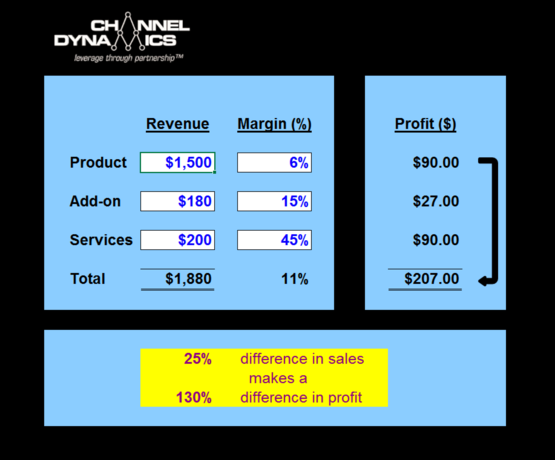It’s funny how things come in waves. In the last month, I’ve had four conversations with four different vendors, concerned that their sales team is not engaging the channel because their reps believe partners add no value. And while I agree that there are certainly partners who add no value, we obviously wouldn’t be in business if we didn’t believe the vast majority of partners do add enormous value.
I think that if you are going to question the value that partners add to your business, there are two other important questions you should also be asking… 1) what value do you want from your partners? and 2) are you, as a vendor, adding value to their business?
Defining value-add
Understanding partner profitability
Put simply, your partner’s profit is actually a blended margin, made up from a combination of three broad categories:
- Your product – the margin they make on the product they purchase from you. This is the most visible element to you as a vendor.
- Related 3rd party products – the margin they make from selling products, from other vendors, that attach to your product. For example, if your technology is virtualisation software, they may sell servers, storage and networking solutions to enable your product. This may also include a cloud product, where the partner is purchasing the solution and reselling it at a margin. The profitability of these elements are less visible to you (as these are not your products) but you can estimate the margin based on the profitability of similar technologies.
- Related services – the margin they make from selling their own services. For example, this may include design, consulting, integration, support, and installation. In this case, there is no variable cost, but there is the partner’s fixed cost, in terms of the staff and/or infrastructure they have established to deliver this. An example of this may also include a cloud solution that the partner developed themselves, and is providing as a service. The profitability of this element is the least visible to you, as it is entirely at the discretion of the partner as to what they deem it to be. Consequently, the only way to determine the profit model is to ask.
Determining your value to the partner
Let’s take a simple example. A partner sells a product (eg. a $1,500 notebook) plus additional related products (eg. $80 laptop bag and $100 travel charger) plus services ($200 to configure it and transfer all documents and settings from your previous machine).
- It’s possible there may have been no sale at all without your product
- The margin from your product is less than 50% of the augmented solution
How can you add value?
- Bring partners in early. It takes time to sell your solutions. Similarly it takes time for partners to sell their services. If you do all the sales work yourself, then bring partners in at the end of the deal, you’re depriving them of the opportunity to sell their services and reducing their profitability.
- Help them sell their services. Partners may make as much, if not more, profit from their services as they do on your product. If you can help promote their services to your customers, you’re genuinely adding value, as they will see you not just delivering product margin, but rather as a facilitator for their total solution.
- Understand the whole product. Spend time with your partners to understand what constitutes an augmented sale for them, so you have a clearer picture of where you fit in. You may discover you’re not as important as you think. But if you understand their value prop, and if you can help them position/message it, you may discover you’re more valuable than you realise.
- Form alliances with other vendors. If your product is typically sold with another more profitable supporting product, it might make sense to form an alliance with that vendor, and provide consolidated benefits to partners who sell both products. (you may also uncover some new partners).
- Look for ways to reduce their cost. Are there any areas where you could provide a solution or service (eg. lead generation or tech support) that can reduce the cost of doing business for a partner. Remember, partners are interested in total profit, so you can also add value by reducing cost, not just by increasing revenue.



